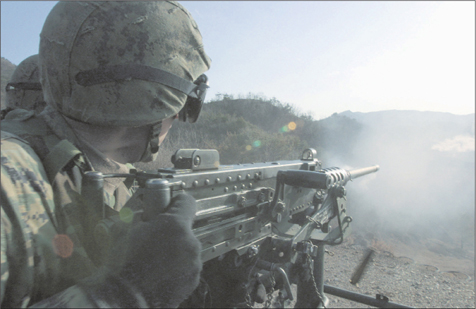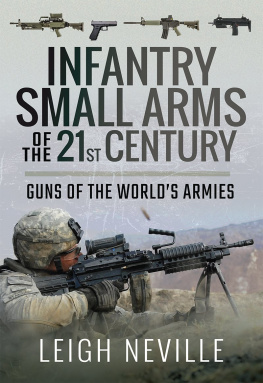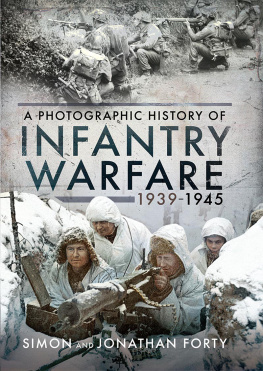Also available in the SAS and Elite Forces Guide series:
Survival Techniques
Sniper
Special Forces in Action
Unarmed Combat

Website: www.amberbooks.co.uk
Appstore: itunes.com/apps/amberbooksltd
Facebook: www.facebook.com/amberbooks/
Twitter: @amberbooks

A US soldier on patrol In Mosul, Iraq, scans the street warily, his M4 carbine held at the ready and ammunition pouches strapped across his chest. Note the front grip on his carbine for more stable handling of the weapon.
CHAPTER ONE
INFANTRY FIREPOWER
A lthough the modern infantry unit can draw upon a massive spectrum of firepower including artillery, armoured support and aerial bombardment it still needs to possess the fundamental skills of small-arms handling to be effective. Without such skills, the unit will be unable to effect the fire-and-manoeuvre tactics so central to competent war fighting, and it will also jeopardize its own safety should support resources not be available. As recent experience in Iraq and Afghanistan has shown, small-arms engagements still occur with great frequency in low-intensity and counter-insurgency warfare, as well as in open conflict, so personal weapons handling remains at the forefront of military training.
THE FAMILY OF WEAPONS
Military units deploy small arms within certain categories, each category complementing the other in terms of firepower and capabilities. The members of this family are: handguns, submachine-guns, rifles and machine-guns.
In military use, handguns have limited applications. Their low penetrative power, relatively poor accuracy and limited range of around 30m (98ft) make them inadequate weapons in substantial firefights. They are primarily used as backup weapons in case of main weapon failure and as precautionary side arms for situations where security issues are not pressing. Typical examples of modern military handguns are the Beretta Model 92 (the standard side arm of the US Army) and the Glock 17/18, both weapons in 9mm (.35in).

NATO troops stop for a communications break during a training exercise. They are armed with a mix of weapons: most have AK assault rifles while one soldier carries the US M16. All the guns are fitted with laser training devices.
Submachine-guns are, in many ways, the least commonly deployed types of small arm in military units. The high rate of fire and low-powered pistol rounds used by weapons such as the 9mm Uzi and the 9mm Ingram Mac 10 make them lethal at very close ranges, but wildly inaccurate for aimed fire. However, Special Forces soldiers use high-quality submachine-guns such as Heckler & Kochs MP5 family for urban counter-terrorist operations, where instant heavy firepower is useful. Beyond that, submachine-guns tend to be used in a similar way to pistols as backup weapons, particularly for armoured vehicle crews (the submachine-guns smaller dimensions ensure that it is easily stowed).
RIFLES
The rifle is the defining small-arms type within infantry units, and each soldier is issued with one as his standard weapon. Most military assault rifles today are either 5.56mm (.21in) firearms such as the US M16A2 and British SA80A2, or 7.62mm (.3in) weapons such as the FN FAL or the infamous AK-47/AKM. (Although even the AK family includes small-calibre rifles such as the 5.45mm AK-74.) Assault rifles command ranges of up to 500m (1640ft), and they provide accurate fire in semi-auto, burst or full-auto modes. By firing rifle cartridges producing muzzle velocities in the region of 1000m/sec (3280ft/sec), rifle rounds offer an increased penetrative capability against commonly encountered structures such as brickwork, plasterboard and thin metal plate, and also impart greater kinetic energy to a human target to increase take-down power.

A British soldier in Basra takes aim through the SUSAT sight fitted to his L86A1. The L86A1 is an extended-barrel version of the SA80 assault rifle, and is intended for light support fire.
A closer look at the M16A2 illustrates the qualities of the modern assault rifle more fully. The M16A2 is a 5.56mm (.223 Remington) rifle with a length of 100.6cm (39.63in) and a weight (loaded with its 30-round magazine) of some 3.99kg (8.79lb). Apart from the barrel and most of the operating parts, the M16A2 is made mostly of high-impact composite materials, which are extremely durable in field use. In combat, the M16A2 has two fire modes: single-shot or three-round burst. The former is used for accurate aimed fire at longer ranges, while the latter is used in intense, shorter-range engagements when the soldier needs to put out heavy suppressive fire. To keep the gun controllable in both modes, the M16A2 is fitted with a muzzle compensator, which reduces muzzle flip and also helps shield the muzzle flash from enemy eyes. The sights are of adjustable aperture type, which give respectable aimed fire out to ranges of around 300m (984ft), the standard factory setting for many military rifles.
Beyond rifles such as the M16 are the high-accuracy, longrange rifles issued to snipers. Calibre types for these weapons vary more significantly, from standard NATO-issue 7.62x51mm (.3x2in) weapons such as the Accuracy International L96A1 and the US M24 Sniper Weapon System (SWS), through to large-calibre rifles such as the .50-calibre Barrett M82A1.
Maximum ranges for these weapons depending on the ammunition type extend from around 800m (2624ft) to 2000m+ (6561ft+) for the .50-calibre weapons.

A US Marine Corps soldier fires the M2HB .50 calibre machine gun, mounted atop a vehicle, during a mechanized raid training exercise in the Republic of Korea.

A prepared machine-gun position, built for a tripod-mounted GPMG. Note that the extensive sandbag protection does not interfere with the traverse of the machine gun.
MACHINE-GUNS
At the top of the tree of infantry small arms are machine-guns. Machine-guns are primarily intended for heavy suppressive fire at area targets, and range from man-portable guns operated by a single individual through to massive, vehicle-mounted weapons. Machine-guns are broken down into three categories: light, medium and heavy machine-guns. Light machine-guns are designed for squad- or fire-team level portability, and today generally utilize the same ammunition types as standard infantry rifles to rationalize unit ammunition usage on the battlefield.
One of the most popular types in use is the FN Minimi, known in US forces as the M249 Squad Automatic Weapon (SAW) and in the British Army as 5.56mm (.21in) Light Machine-gun (LMG).
The Minimi fires the standard 5.56mm round used by many Western assault rifles, including the SA80 and M16, and has a cyclical rate of fire of between 700 and 1000rpm. Although the individual rounds carry no more destructive force than those fired from a standard rifle, such a heavy volume of fire makes the Minimi a powerful battlefield presence.
Next page














